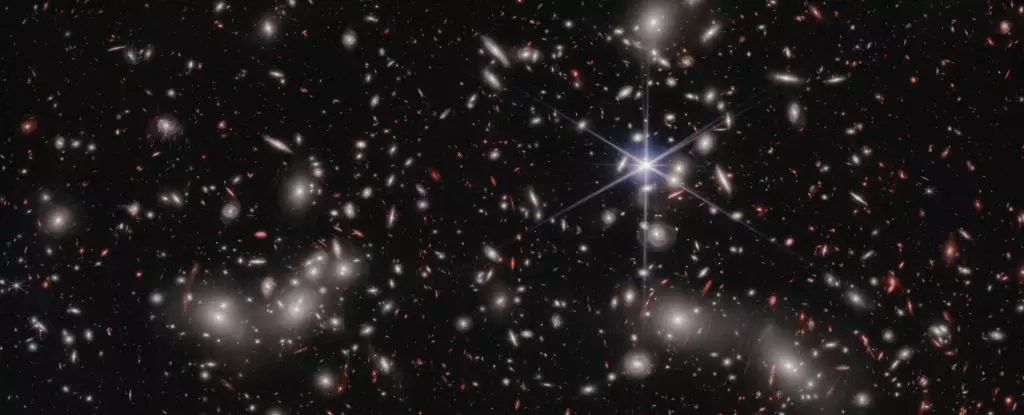The early Universe has long been a subject of fascination and mystery, a time shrouded in darkness and uncertainty. Recent groundbreaking research harnesses the power of advanced telescopes like Hubble and the James Webb Space Telescope (JWST) to shine new light on this enigmatic epoch. A pivotal study published in February 2024 reveals that dim dwarf galaxies, previously overlooked, played a decisive role in “clearing the fog” of the early cosmos, turning what was once a murky expanse into a vibrant tapestry filled with light and energy. The implications of this discovery extend far beyond academic interest; they reshape our understanding of how the Universe evolved following the Big Bang.
From Darkness to Light: The Evolution of Cosmic Conditions
In the immediate aftermath of the Big Bang, the Universe was suffocated by a dense fog of ionized plasma, and the photons produced were essentially unable to escape this shroud. Observations suggest that this plasma persisted for roughly 300,000 years, during which time light allowed by the neutral hydrogen formed therein simply could not penetrate. The transformation began when protons and electrons combined to form hydrogen and a small percentage of helium. As cooling occurred, the first stars ignited, introducing high-energy radiation that could reionize the gas, thus allowing light to travel freely across the cosmos.
The era dubbed the “cosmic dawn,” which began about a billion years post-Big Bang, marks the profound shift when the Universe became entirely reionized. This transition from darkness to light wasn’t merely a matter of celestial fireworks; it was a crucial turning point that laid the foundation for the structure of the Universe as we see it today.
Dwarf Galaxies: The Unsung Heroes
Initially, astronomers posited that the leading lights responsible for this reionization were massive structures like sprawling galaxies and sizable black holes, which emit considerable radiation as they devour surrounding matter. However, the findings from JWST, analyzing the galaxy cluster Abell 2744, illuminate a different reality. It turns out that these dwarf galaxies are not only more numerous than their massive counterparts, but they are also far more influential in terms of energy emissions than previously understood. In fact, data points to a striking ratio of 100 to 1 in favor of dwarf galaxies when comparing their abundance to larger galaxies.
This observation changes the narrative surrounding the cosmic dawn. Rather than being mere footnotes in the grand story of cosmic history, dwarf galaxies emerge as robust contributors, collectively producing energy that far exceeds what’s emitted from larger galaxies. Astrophysicist Hakim Atek and his team emphasize that these small but mighty galaxies wield substantial power, acting as pivotal players in shaping the early Universe’s dynamism.
The Role of Innovative Technology
A significant aspect of this discovery is due to the immense capabilities of the JWST, designed to delve deeper into the cosmos than ever before. By using gravitational lensing effects to focus on the dense regions of space-time around the Abell 2744 galaxy cluster, this advanced telescope has enabled scientists to identify and analyze these tiny, yet luminous, dwarf galaxies. The lensing effect warps the light coming from distant objects, magnifying their visibility and allowing astronomers to gather a wealth of details that were previously thought to be lost in the cosmic fog.
With every observation, astronomers are peeling back layers of understanding surrounding our Universe’s history. Such breakthroughs underline the importance of continued investment in ambitious space exploration and the technologies that support it. The JWST’s success highlights a new frontier in cosmic knowledge and offers tantalizing glimpses into epochs that are foundational to the fabric of reality.
The Path Ahead: Confirming the Findings
Despite the excitement surrounding these findings, the journey does not end here. The researchers caution against concluding that their observations represent a universal truth until they conduct further studies across a broader range of cosmic regions. The next step involves examining other areas of the sky that exhibit similar gravitational lensing effects, reinforcing the reliability of their conclusions about dwarf galaxies and their contribution to cosmic reionization.
As they embark on this ambitious road ahead, the field of astrophysics stands poised on the precipice of transformative enlightenment. For decades, researchers searched for answers to the mystery of cosmic reionization, and now they may finally be inching closer to illuminating the shadowy spaces of our early Universe.
Through tireless exploration and groundbreaking discoveries, we are beginning to appreciate the profound legacy that diminutive entities like dwarf galaxies hold in telling the tale of our cosmic origins. The lights may be on, but our journey to truly understand what they illuminate is just beginning.

